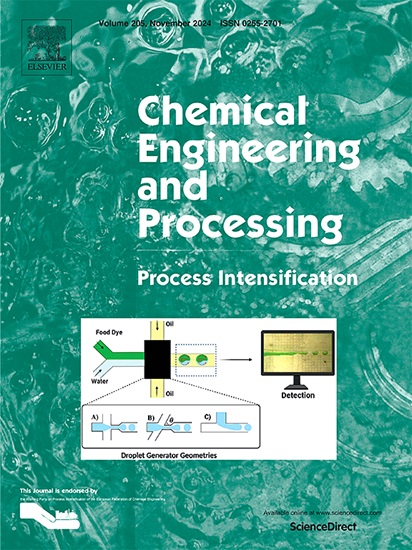Crude palm stearin: A green and fast fractionation method to obtain a natural oil structuring agent
IF 3.8
3区 工程技术
Q3 ENERGY & FUELS
Chemical Engineering and Processing - Process Intensification
Pub Date : 2025-07-15
DOI:10.1016/j.cep.2025.110450
引用次数: 0
Abstract
This work investigated the effect of temperature control on crystallization and centrifugation of the crude palm oil aiming to fractionate it into crude palm stearin (CPS) and crude palm olein (CPO), and to explore the potential use of CPS as a structuring agent for soybean oil.Fractionation was carried out using a slightly modified oil-binding capacity method, where the temperatures of 10, 15, 20, and 25 °C were applied at crystallization and centrifugation. Purity of CPO was demonstrated through differential scanning calorimetry. Further, CPS fraction was evaluated as structuring agent for soybean oil carrying out differential scanning calorimetry, small-angle controlled stress dynamic rheology, polarized light microscopy, and X-ray diffraction analyses. A strong influence of temperature was observed on the CPS and CPO fractions yields. The 25 °C was considered the best temperature for crystallization and centrifugation. The CPS in soybean oil at 50 % (w/w) developed a solid-like behavior due to dispersion of needle-like crystal organized in cluster. Thermal and rheological behavior, and crystal-like morphology and crystallinity observed are similar to the frequently repported on organogels, indicating its potential as a natural and minimally processed ingredient or additive for food and pharmaceutical formulations.

棕榈硬脂:一种绿色、快速的分离方法,可获得天然的油结构剂
本文研究了温度控制对粗棕榈油结晶和离心的影响,目的是将粗棕榈油分离成粗棕榈硬脂(CPS)和粗棕榈油(CPO),并探讨了粗棕榈硬脂(CPS)作为大豆油结构剂的潜力。采用稍微改进的油结合容量法进行分馏,在10、15、20和25℃的温度下进行结晶和离心。通过差示扫描量热法证实了CPO的纯度。此外,通过差示扫描量热法、小角可控应力动态流变学、偏振光显微镜和x射线衍射分析,对CPS馏分作为大豆油的结构剂进行了评价。温度对CPS和CPO馏分的产率有较大影响。25℃被认为是结晶和离心的最佳温度。在50% (w/w)时,大豆油中的CPS由于簇状针状晶体分散而表现出固体状行为。观察到的热流变行为、晶体状形态和结晶度与经常报道的有机凝胶相似,表明其作为食品和药物配方的天然和最低加工成分或添加剂的潜力。
本文章由计算机程序翻译,如有差异,请以英文原文为准。
求助全文
约1分钟内获得全文
求助全文
来源期刊
CiteScore
7.80
自引率
9.30%
发文量
408
审稿时长
49 days
期刊介绍:
Chemical Engineering and Processing: Process Intensification is intended for practicing researchers in industry and academia, working in the field of Process Engineering and related to the subject of Process Intensification.Articles published in the Journal demonstrate how novel discoveries, developments and theories in the field of Process Engineering and in particular Process Intensification may be used for analysis and design of innovative equipment and processing methods with substantially improved sustainability, efficiency and environmental performance.

 求助内容:
求助内容: 应助结果提醒方式:
应助结果提醒方式:


